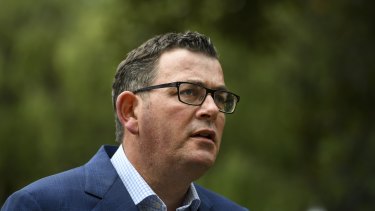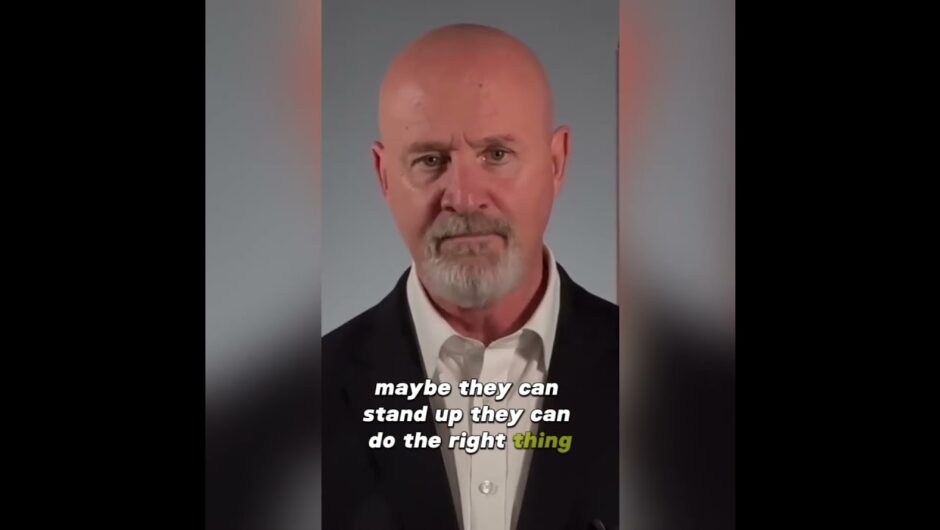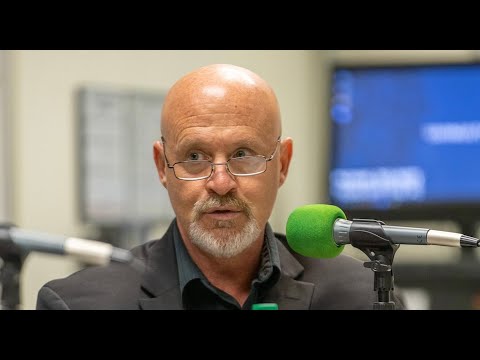Victoria’s current COVID-safe summer restrictions stipulate a maximum of 100 people can meet outdoors in a public place.
“Marshals will ensure that each group of 100 participants maintains a 10-metre distance from other groups while stationary and while moving,” the plan said. “Marshals will also manage the entry and exit of groups of 100.”
Protesters at the Black Lives Matter rally in Melbourne in June last year.Credit:Chris Hopkins
Registering via QR codes would also be compulsory for attendees, the group said.
More than 2500 people have indicated on the group’s Facebook page that they would attend the Invasion Day protest in Melbourne, despite Premier Daniel Andrews warning Victorians to stay away as large gatherings are still banned under coronavirus rules.
Another 2300 have said they’re interested in attending the protest.
Protesters are set to meet on the steps of Parliament at 10.30am on Tuesday and the rally is expected to finish at 2pm.

Victoria’s Premier Daniel Andrews.Credit:Penny Stephens
The protest – which calls for sovereignty and social justice for Indigenous Australians – previously coincided with Melbourne’s official Australia Day parade, which has been cancelled this year because of the coronavirus.
Mr Andrews said on Thursday that it wasn’t the time for protests.
Loading
“This will be a different Australia Day; we’re in the midst of a global pandemic,” he said.
“It’s no time to be protesting, it just isn’t. We’ve built something precious and unique, Victorians have, through their sacrifice and their commitment and their compassion for each other and we have to safeguard that.”
Mr Andrews’ comments were hit with a swift retort from Greens Senator Lidia Thorpe, a Gunnai Gunditjmara and Djab Wurrung woman, who pushed back against the warning, saying rally organisers would follow advice from medical experts, not the Premier.
Mr Andrews made similar comments before last year’s Black Lives Matter rallies, when tens of thousands of anti-racism protesters defied COVID-19 health warnings to take to the streets as Melbourne’s second wave of cases grew.
Three organisers of last year’s event, which passed without any arrests amid a heavy police presence, were each fined $1652 for breaching coronavirus restrictions.
Chief Health Officer Brett Sutton urged organisers of the protest to go through the state’s public event process to ensure it was COVID-safe.

Thousands marched through the streets of Melbourne to protest Australia Day last year, before COVID-19 took hold in the country.Credit:Chris Hopkins
“The concern about any protest is that they do not necessarily have those mitigations in place and I would encourage any event organiser, protest or otherwise, to go through the public events process to make sure those mitigations are locked in,” he said.
On Thursday, three senior public health experts agreed that while the risk of an outbreak could not be ruled out, the danger would be minimal while there was no community transmission of COVID-19 and if precautions were taken by protesters.
Loading
University of Sydney infectious diseases expert Robert Booy said “given the direction we’re heading, with low transmission rates in the community and with high observance of appropriate precautions, the smoothest path may well be to allow protests within appropriate bounds”.
“If we take all the best possible precautions, like having a limited number [of people] at a limited time, ensuring people wear face masks, use hand gel, social distance, this all minimises the risk.”
University of South Australia epidemiologist Adrian Esterman said: “There is risk in holding this protest, but it is quite minimal”.
La Trobe University epidemiologist Hassan Vally said the protest posed a dilemma because it was a situation where public health was colliding with an emotionally charged social issue.
“If you put your public health blinkers on and detach yourself from the emotion of it, from a scientific perspective we know that having large groups of people together is not consistent with everything that we’ve done over the past 12 months to protect people,” Professor Vally said.
“On the other side of this, it is understanding that people strongly believe that these issues transcend everything else that’s going on and they see it as vitally important to have their voices heard.”
Professor Vally said Victoria had seen first-hand how quickly the virus could spread and it was paramount if people attended the rally they followed public health advice.
“The worst-case scenario is that there is a super-spreader in a huge crowd who could infect a lot of people that will all go back to different areas of Melbourne, and two weeks later we will have hundreds or thousands of cases,” he said. “That’s our biggest fear.”
Loading
Last year, tens of thousands of Australians took to the streets at Invasion Day rallies, calling for Australia Day, which marks the anniversary of the arrival of the British First Fleet in 1788, to be abolished.
A Victoria Police spokeswoman said officers will be out in force to ensure those taking part in rallies comply with public health directives.
“There are a number of planned demonstrations expected to take place in the CBD and there will be a strong police presence at any planned rallies in order to maintain public safety,” she said.
“Anyone looking to attend an event to cause trouble can expect a firm response from police. You will be arrested and held to account if you commit a crime.”
The Australian Open is still scheduled to go ahead despite 72 competitors being confined to their hotel rooms ahead of its scheduled start on February 8 following a spate of positive cases linked to the event. Authorities have not yet announced how many spectators will be permitted at the tournament.
Cricket Australia also confirmed this month that the fourth and final Test between Australia and India will be played at the Gabba as scheduled, under strict quarantine protocols.
Warriors of the Aboriginal Resistance have been contacted for comment.
Melissa Cunningham is The Age’s health reporter.
Most Viewed in National
Loading







